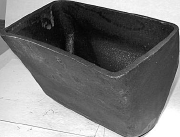Rugged development Type “MD” Buckets are most well-liked for common goal elevators. Covering a wide array of sizes from 4 to twenty inches prolonged, they are really applied for ?ne and medium size components such as coal, cement, pulp, grain, ear corn, etc. These are broadly used for hefty abrasive elements such as sand, gravel, and stone. Reinforced front lips give Type “MD” Buckets an extended sporting digging edge. Uniform wall thickness and powerful corner reinforcement make them stronger than steel buckets of your same gauge.They’re smoothly surfaced and also have ends sloped inward at 6 degree angles to insure right ?lling and clean discharge. Accessible in Malleable and Al-lied-Locke Promal.
Chain for which buckets can be found in-clude: Steel Bushed Roller, Steel Bushed, Combination, “H” Class Mill, 400 Class Pin-tle, and 700 Class Pintle. “MD” Buckets are utilised with G1, G6, K1, or K2 type attach-ments after they are available from the chain kind.
Capacities are for buckets ?lled to your line XX (see diagram). The practical operating capacity will differ with all the loading disorders, angle of re-pose of the material becoming dealt with, plus the incli-nation from the elevator.
Fashion “AC” ELEVATOR BUCKETS for managing cement, lime, and ?uffy materials
Fashion “AC” Buckets give quickly, thorough discharge of cement, lime, and various dry, ?uffy products. Vent holes during the bottom of every bucket release trapped air in ?lling and make  it possible for materials to empty from bucket promptly and wholly on discharge. Additionally to reinforcing lips, hooded backs reinforce “AC” Design Buckets. This characteristic permits closer bucket spacing and provides 30% better carrying capability than other bucket types from the very same length. These sturdy buckets have an extra thickness of metal at wear factors for longer support. Available in Al-lied-Locke Malleable and Promal.
it possible for materials to empty from bucket promptly and wholly on discharge. Additionally to reinforcing lips, hooded backs reinforce “AC” Design Buckets. This characteristic permits closer bucket spacing and provides 30% better carrying capability than other bucket types from the very same length. These sturdy buckets have an extra thickness of metal at wear factors for longer support. Available in Al-lied-Locke Malleable and Promal.
Type “AC” Buckets usually are used with heavy duty engineering chain this kind of as Bushed Steel Chain with K2 and K3 type attachments.
Capacities are for buckets ?lled to both line XX or YY (see diagram). The useful operat-ing capacity will differ with loading problems, angle of repose of the materials being dealt with, as well as inclination from the elevator.